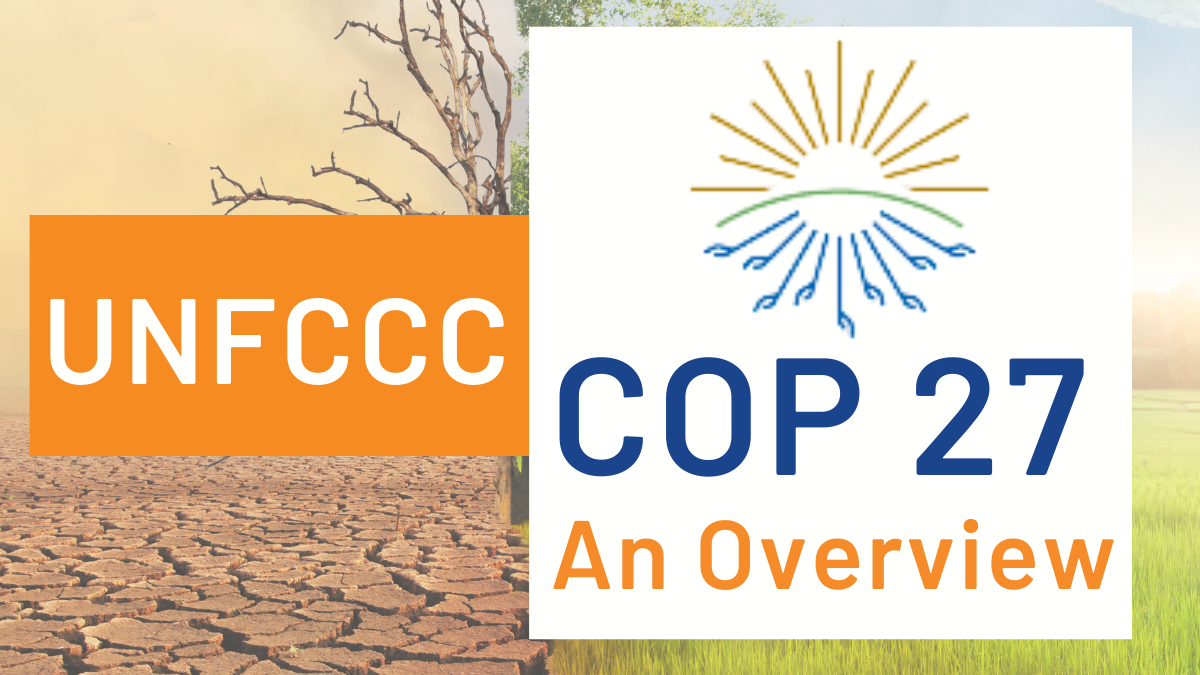“We are in a life-or-death struggle for our own safety today and our survival tomorrow. There is no time for pointing fingers or twiddling thumbs. The world cannot wait”– The UN Secretary General spoke on the eve of the COP 27 of UNFCCC, pointing out the paucity of time in addressing the rising emissions and its consequences on climate change. The COP 27 of UNFCCC was held in Sharm el-Sheikh, Egypt from 6th to 20th of November 2022.

What is UNFCCC?
It stands for United Nations Framework Convention on Climate Change. An international environmental treaty signed in 1992 during the Earth Summit, it entered into force in 1994. It aims at stabilization of greenhouse gas concentration in the atmosphere in a time frame to allow the ecosystem to adapt to climate change. The UNFCCC’s ultimate goal is to prevent “dangerous” human involvement with the climate system.
The Conference of Parties (COP) is the highest decision making body of UNFCCC. The agenda and issues connected to climate change that need to be worked on are decided at the COP’s annual sessions.
Brief History of Climate Action
STOCKHOLM SUMMIT & UNEP:
The issue of Climate Change was only realised in the year 1972 at the Stockholm Summit. It also resulted in the establishment of United Nations Environment Protection (UNEP) in the same year. However, Climate Change as an issue was still not at the centre stage.
IPCC & MONTREAL PROTOCOL:
The increasing ozone depletion & global warming became an international issue and part of political debate. This led to the establishment of the Intergovernmental Panel on Climate Change (IPCC) in 1988. IPCC was to examine the GHG & its effects on global warming. The culmination of all the efforts resulted in the Montreal Protocol on Substances that deplete Ozone Layer. It entered into force in 1989.
RIO EARTH SUMMIT- UNCED:
In 1990, the 2nd World Climate Conference highlighted Climate Change as a global issue & emphasized on the need to negotiate at global level. The need to have an urgent response to environmental issues increased and 1992 the General Assembly convened Rio Earth Summit also known as UN Conference on Environment & Development (UNCED).
UNFCCC & 1st COP:
It was at the UNCED, that the UNFCCC Convention along with UNCBD & UNCCD was opened for signature. The UNFCCC was entered into force in 1994 and the 1st COP was held in Berlin. It held discussions about protocol and the need of developed countries making more enduring commitments.
KYOTO PROTOCOL:
Thus, the subsequent approval of the Kyoto Protocol in 1997 is one of the most significant & successful climate change initiatives to date. It was designed to lower the carbon dioxide and GHG emissions from industrialised nations. It was formally adopted in COP 3.
PARIS AGREEMENT:
The Paris Agreement adopted in COP 21 was another landmark event in climate action. It aimed at keeping the global temperature below 2 degree Celsius above pre-industrial times and further keep it down to below 1.5 degree Celsius. Further in COP 22 in Glasgow, India pledges its Net Zero target in 2070.
COP 27, Sharm el- Sheikh
More than 200 countries participated in this year’s COP at Egypt. The theme of this year’s Summit was ‘The Implementation COP’ to underline the importance of implementing things agreed upon in the previous COPs.
The major outcome of COP 27 was the ‘Loss & Damage Fund’ incorporated to help the most vulnerable developing countries in times of devastating natural calamities. Also, the summit stuck to the existing commitment of keeping the global temperature less than 1.5 degree Celsius. Further, there was no attention given to reducing the use of fossil fuels and commitments related to it.
The Summit also saw, for the first time, mention of special chapters on forest, oceans and food, thereby establishing link between protection of nature and climate change. It further asserts that we shouldn’t let geopolitical disputes and associated problems take away our focus from combating climate change and keeping our promises regarding it.
COP 27 & India
India participated in the Summit with the promotion of LiFE. The concept of LiFE (Lifestylefor Environment) was introduced by our Prime Minister at COP 26. It is aimed at mobilizing at least 1 billion citizens to take individual & collective actions to protect the environment.
The “Lost & Damage Fund,” the main outcome of COP 27, will primarily be used for the most vulnerable countries. Additionally, the heavily emitting developing nations are expected to contribute. India, one of the biggest GHG polluters, might not gain from it. Also, India might be at a disadvantage given the greater proportion of poor and vulnerable people in the nation.
Conclusion
The annual sessions of COPs hardly derive any concrete deal for Climate Change. This year’s COP 27 was extended by another 2 days to come up with an agreement, and thus came the ‘Loss & Damage Fund’ at the dying moments of the summit.
Thus, it is clear that there is a lack of cooperation among the parties. Everyone is in favour of a deal that suits their needs & requirements. As the UN Secretary General has warned that “the world cannot wait”, hence it is important to keep the differences aside and come together to deal with the menace of Climate Change. It is only by adhering to the SDG Goal no. 17 of ‘Partnership for the Goals’ we can come up stronger against Climate Change in the near future.
To help you prepare 50% faster for competitive exams, ixamBee provides free Mock Test Series all the Current Affairs in English and Current Affairs in Hindi in the BeePedia capsules for GA Preparation. You can also get the latest updates for Bank PO, Bank Clerk, SSC, RBI NABARD and Other Government Jobs.
Also Read:
Importance of CONCEPTUAL CLARITY to clear ANY Government Exam
DEBUNKING THE MYTHS OF RBI GRADE B EXAM















